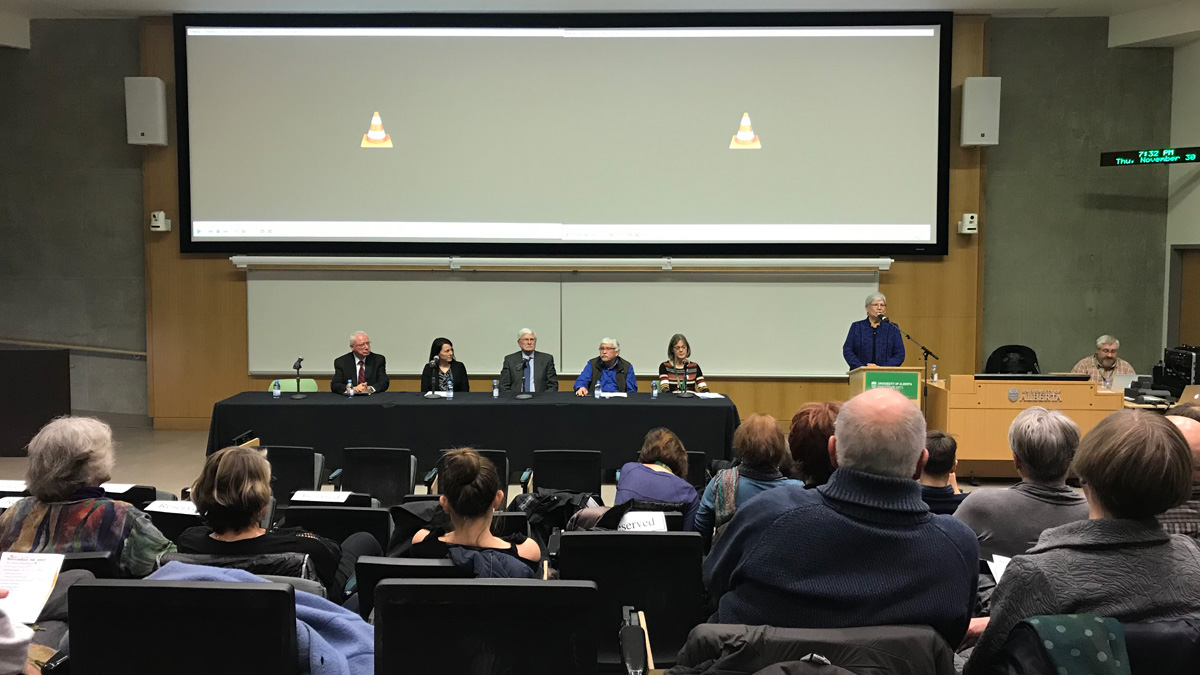Remembering Olive Dickason, a trail-blazing Métis historian
 Regan Brodziak
Regan BrodziakOn November 30, friends and strangers gathered to celebrate the legacy of Olive Dickason, an award-winning journalist, human rights activist, and University of Alberta Métis historian who died in 2011.
The event at the Edmonton Clinic Health Academy featured a brief screening of the film Olive Dickason’s First Nations followed by a roundtable discussion and reception. The roundtable members spoke of Olive’s energy, her inquisitiveness, and her passion.
“When she entered a classroom and began to lecture, she had this glint in her eye,” said roundtable member Elder Elmer Ghostkeeper. “She became very animated and was actually living the story.”

As a single mother of three, Dickason conquered the field of journalism. She wrote for the Winnipeg Free Press, the Montreal Gazette, and the Globe and Mail, and won multiple awards along the way. After discovering her Métis ancestry, she used her journalism platform to advocate for Indigenous and women’s rights.
Dickason didn’t follow the traditional path to academia. It wasn’t until she was 57 that she decided to pursue her PhD at the University of Ottawa. Her doctoral thesis, “The Myth of the Savage,” would become one of her defining works. After completing her PhD, Dickason became a professor at the U of A.
In 1992, Dickason published Canada’s First Nations: A History of Founding Peoples from Earliest Times. According to Lesley Cormack, the U of A’s Dean of Arts, this work redefined Canadian history. At the event, Cormack talked about how Dickason provided the first written account of Indigenous history. Even more impressive, she said, is that she did so when the scholarly field of Aboriginal studies barely existed.
“The term trailblazer is often bandied about,” Cormack said. “But for Olive Dickason, the description not only fits, but in so many ways personifies her.”
When she turned 65, less than 10 years into her academic career, Dickason was forced to retire because of the U of A’s mandatory retirement policy at the time. She spent the next 10 years fighting for her right to work, making it all the way to the Supreme Court. Though the Court did ultimately uphold the mandatory retirement policy, for Dickason, it was a moral victory, said Naomi Szigeti, Dickason’s granddaughter. The mandatory retirement policy was in fact abolished in 2007, a feat that David Johnson attributes to Dickason. As the then President of the Academic Staff Association, Johnson played a role in the movement to have the policy abolished.
“What kept me going was thinking of Olive’s example and Olive’s spirit,” he said.
But Dickason was more than just a renowned academic. She was also a beloved friend. Elder Marilyn Buffalo spoke fondly of their time together at the U of A, recalling the tap-dancing lessons their group of friends took together.
“She reminded me of my mother,” Buffalo said. “I saw in her a very powerful woman for whom nothing was impossible.”
Szigeti was also one of the roundtable speakers and spoke of how her grandmother influenced her both personally and professionally, inspiring her to become the lawyer that she is today. Szigeti now works with the Department of Justice in human rights law, but her first job after law school was with the law firm that represented her grandmother in her mandatory retirement battle at the Supreme Court.
“She showed me what determination really meant,” she said. “And how staying true to your values, especially through the challenges, is where true satisfaction in life is often found.”
Szigeti spoke of how her grandmother’s enthusiasm never stopped. She continued to live with energy, passion, conviction, and pride. Because of this, the roundtable members said, her legacy will live on.
“Olive Dickason planted her foot,” Elder Buffalo said. “She stepped right here.”




